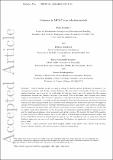Files in this item
Inference in MCMC step selection models
Item metadata
| dc.contributor.author | Michelot, Théo | |
| dc.contributor.author | Blackwell, Paul G. | |
| dc.contributor.author | Chamaillé-Jammes, Simon | |
| dc.contributor.author | Matthiopoulos, Jason | |
| dc.date.accessioned | 2020-12-09T00:37:25Z | |
| dc.date.available | 2020-12-09T00:37:25Z | |
| dc.date.issued | 2019-12-09 | |
| dc.identifier | 262738854 | |
| dc.identifier | 90416273-5b71-44d2-871b-ae3d3bd3b143 | |
| dc.identifier | 85076749288 | |
| dc.identifier | 000501325300001 | |
| dc.identifier.citation | Michelot , T , Blackwell , P G , Chamaillé-Jammes , S & Matthiopoulos , J 2019 , ' Inference in MCMC step selection models ' , Biometrics , vol. Early View . https://doi.org/10.1111/biom.13170 | en |
| dc.identifier.issn | 0006-341X | |
| dc.identifier.other | RIS: urn:81DC4D9DD95D594CECA704DAA8A1DBED | |
| dc.identifier.uri | https://hdl.handle.net/10023/21123 | |
| dc.description | TM was funded by the Leverhulme Trust, award number DS-2014-081. SCJ was supported by the grant ANR-16-CE02-0001-01 of the French Agence Nationale de la Recherche. | en |
| dc.description.abstract | Habitat selection models are used in ecology to link the spatial distribution of animals to environmental covariates and identify preferred habitats. The most widely used models of this type, resource selection functions, aim to capture the steady‐state distribution of space use of the animal, but they assume independence between the observed locations of an animal. This is unrealistic when location data display temporal autocorrelation. The alternative approach of step selection functions embed habitat selection in a model of animal movement, to account for the autocorrelation. However, inferences from step selection functions depend on the underlying movement model, and they do not readily predict steady‐state space use. We suggest an analogy between parameter updates and target distributions in Markov chain Monte Carlo (MCMC) algorithms, and step selection and steady‐state distributions in movement ecology, leading to a step selection model with an explicit steady‐state distribution. In this framework, we explain how maximum likelihood estimation can be used for simultaneous inference about movement and habitat selection. We describe the local Gibbs sampler, a novel rejection‐free MCMC scheme, use it as the basis of a flexible class of animal movement models, and derive its likelihood function for several important special cases. In a simulation study, we verify that maximum likelihood estimation can recover all model parameters. We illustrate the application of the method with data from a zebra. | |
| dc.format.extent | 10 | |
| dc.format.extent | 862232 | |
| dc.language.iso | eng | |
| dc.relation.ispartof | Biometrics | en |
| dc.subject | Animal movement | en |
| dc.subject | Local Gibbs sampler | en |
| dc.subject | Markov chain Monte Carlo | en |
| dc.subject | MCMC step selection | en |
| dc.subject | Resource selection function | en |
| dc.subject | Step selection function | en |
| dc.subject | Utilization distribution | en |
| dc.subject | QA Mathematics | en |
| dc.subject | QH301 Biology | en |
| dc.subject | DAS | en |
| dc.subject.lcc | QA | en |
| dc.subject.lcc | QH301 | en |
| dc.title | Inference in MCMC step selection models | en |
| dc.type | Journal article | en |
| dc.contributor.institution | University of St Andrews. Statistics | en |
| dc.identifier.doi | https://doi.org/10.1111/biom.13170 | |
| dc.description.status | Peer reviewed | en |
| dc.date.embargoedUntil | 2020-12-09 |
This item appears in the following Collection(s)
Items in the St Andrews Research Repository are protected by copyright, with all rights reserved, unless otherwise indicated.

